营销管理考试复习重点.pptx
- 格式:pptx
- 大小:402.69 KB
- 文档页数:30

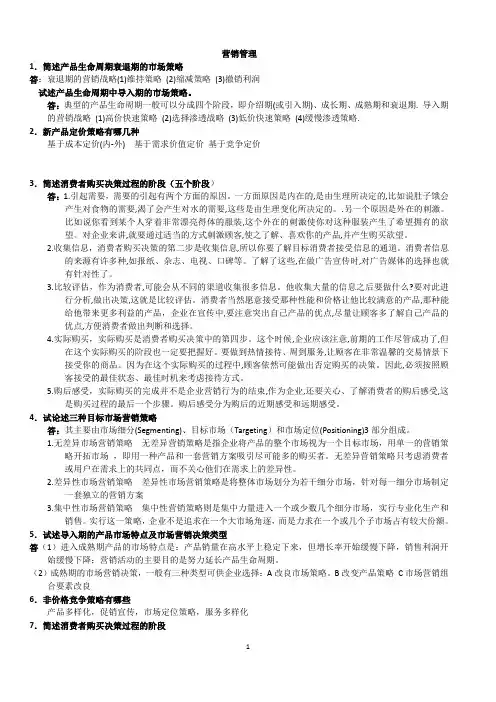
营销管理1.简述产品生命周期衰退期的市场策略答:衰退期的营销战略(1)维持策略(2)缩减策略(3)撤销利润试述产品生命周期中导入期的市场策略。
答:典型的产品生命周期一般可以分成四个阶段,即介绍期(或引入期)、成长期、成熟期和衰退期. 导入期的营销战略(1)高价快速策略(2)选择渗透战略(3)低价快速策略(4)缓慢渗透策略.2.新产品定价策略有哪几种基于成本定价(内-外) 基于需求价值定价基于竞争定价3.简述消费者购买决策过程的阶段(五个阶段)答:1.引起需要,需要的引起有两个方面的原因。
一方面原因是内在的,是由生理所决定的,比如说肚子饿会产生对食物的需要,渴了会产生对水的需要,这些是由生理变化所决定的。
.另一个原因是外在的刺激。
比如说你看到某个人穿着非常漂亮得体的服装,这个外在的刺激使你对这种服装产生了希望拥有的欲望。
对企业来讲,就要通过适当的方式刺激顾客,使之了解、喜欢你的产品,并产生购买欲望。
2.收集信息,消费者购买决策的第二步是收集信息,所以你要了解目标消费者接受信息的通道。
消费者信息的来源有许多种,如报纸、杂志、电视、口碑等。
了解了这些,在做广告宣传时,对广告媒体的选择也就有针对性了。
3.比较评估,作为消费者,可能会从不同的渠道收集很多信息。
他收集大量的信息之后要做什么?要对此进行分析,做出决策,这就是比较评估。
消费者当然愿意接受那种性能和价格让他比较满意的产品,那种能给他带来更多利益的产品,企业在宣传中,要注意突出自己产品的优点,尽量让顾客多了解自己产品的优点,方便消费者做出判断和选择。
4.实际购买,实际购买是消费者购买决策中的第四步。
这个时候,企业应该注意,前期的工作尽管成功了,但在这个实际购买的阶段也一定要把握好。
要做到热情接待、周到服务,让顾客在非常温馨的交易情景下接受你的商品。
因为在这个实际购买的过程中,顾客依然可能做出否定购买的决策。
因此,必须按照顾客接受的最佳状态、最佳时机来考虑接待方式。
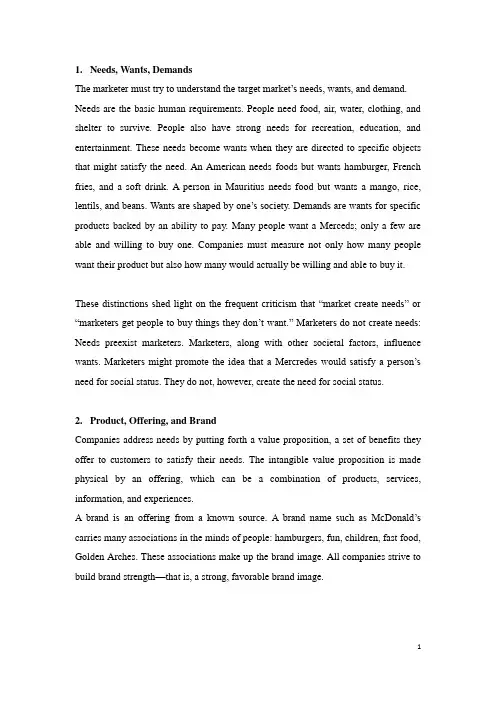
1.Needs, Wants, DemandsThe marketer must try to understand the target market’s needs, wants, and demand. Needs are the basic human requirements. People need food, air, water, clothing, and shelter to survive. People also have strong needs for recreation, education, and entertainment. These needs become wants when they are directed to specific objects that might satisfy the need. An American needs foods but wants hamburger, French fries, and a soft drink. A person in Mauritius needs food but wants a mango, rice, lentils, and beans. Wants are shaped by one’s society. Demands are wants for specific products backed by an ability to pay. Many people want a Merceds; only a few are able and willing to buy one. Companies must measure not only how many people want their product but also how many would actually be willing and able to buy it.These distinctions shed light on the frequent criticism that “market create needs” or “marketers get people to buy things they don’t want.” Marketers do not create needs: Needs preexist marketers. Marketers, along with other societal factors, influence wants. Marketers might promote the idea that a Mercredes would satisfy a person’s need for social status. They do not, however, create the need for social status.2.Product, Offering, and BrandCompanies address needs by putting forth a value proposition, a set of benefits they offer to customers to satisfy their needs. The intangible value proposition is made physical by an offering, which can be a combination of products, services, information, and experiences.A brand is an offering from a known source. A brand name such as McDonald’s carries many associations in the minds of people: hamburgers, fun, children, fast food, Golden Arches. These associations make up the brand image. All companies strive to build brand strength—that is, a strong, favorable brand image.3.The four P components of marketing mix保证品种库存Four Ps: product, price, place, promotionV全对方背叛四舍五入啊咧电瓶车食品啊骗人的吗猜猜爱丽i团Mix 四基本要素Four Cs: customer solution, customer cost, convenience, communication 顾客成本方便沟通pany orientations toward the marketplaceWe have defined marketing management as the conscious effort to achieve desired exchange outcomes with target markets, but what philosophy should guide a company’s marketing efforts? What relative weights should be given to the interests of the organization, the customers, and society? Very often these interests conflict.Marketing activities should be carried out under a well-thought-out philosophy of efficiency, effectiveness, and social responsibility. However, there are six competing concepts under which organizations conduct marketing activities: the production concept, product concept, selling concept, marketing concept, consumer concept, and societal marketing concept.1)The production conceptThe production concept is one of the oldest concepts in business. The production concept holds that consumers will prefer products that are widely available and inexpensive. Managers of production-oriented businesses concentrate on achieving high production efficiency, low costs, and mass-distribution. They assume that consumers are primarily interested in product availability and low prices. This orientation makes sense in developing countries, where consumers are more interested in obtaining the product than in its feature. It is also used when a company wants to expand the market.Some service organizations also operate on the production concept. Many medical and dental practices are organized on assembly-line principles, as are some government agencies (such as unemployment offices and license bureaus). Although this management orientation can handle many cases per hour, it is often to charge of impersonal and poor-quality service.2)The product conceptOther businesses are guided by the product concept, which holds that consumers will favor those products that offer the most quality, performance, or innovative features. Managers in these organizations focus on marketing superior products and improving them over time. They assume that buyers admire well-made products and can evaluate quality and performance. However, these managers are sometimes caught up in a love affair with their products. Management might commit the “better-mousetrap” fallacy, believing that a better mousetrap will lead people to lead beat a path to its door. Such was the case when WebTV was launched during Christmas 1996 to disappointing results.Product-oriented companies often trust that their engineers can design exceptional products. They get little or no customer input, and very often they will not even examine competitors’ products. A general Motors executive said years ago: “how can the public know what kinds of car they want until they see wh at is available?” GM’s designers and engineers would design the new car. Then manufacturing would make it. The finance department would price it. Finally, marketing and sales would try to sell it. No wonder the car required such a hard sell! Today GM asks customers what they value in a car and includes marketing people in the very beginning stages of design.The product concept can lead to what Theodore Levitt called “marketing myopia.” He pointed out that customers do not buy drill bits—they buy ways to make holds. Railroad management thought that travelers wanted trains and overlooked the growing competition for transportation from airlines, buses, trucks, and automobiles. Coca-Cola, focused on its soft-drink business, missed seeing the market for coffee bars and fresh-fruit juice bars that eventually impinged on its soft-drink business. McDonald’s is in danger of over focusing on its hamburger business while many diners are turning to sandwiches, pizza, tacos, and other fast food. These organizations are looking into a mirror when they should be looking out the window.3)The selling conceptThe selling concept is another common business orientation. The selling concept holds that consumers and business, if left alone, will ordinarily not buy enough of the organization’s products. The organization must, therefore, undertake an aggressive selling and promotion effort. This concept assumes that consumers typically show buying inertia or resistance and must be coaxed into buying. It also assumes that the company has a whole battery of effective selling and promotion tools to stimulate more buying. The selling concept is epitomized by the thinking of Sergio Zyman, Coca-Cola’s former vice president of marketing: the purpose of marketing is to sell more stuff to more people more often for more money in order to make more profit.The selling concept is practiced most aggressively with unsought goods, goods that buyers normally do not think of buying, such as insurance, encyclopedias, and funeral plots. These industries have perfected various sales techniques to locate prospects and hard sell them on their products’ benefits. The selling concept is also practiced in the nonprofit area by fund-raisers, college admissions offices, and political parties.A political pa rty “sells” its candidates to voters. The candidate moves through voting precincts from early morning to late evening, shaking hands, kissing babies, meeting donors, and making speeches. Countless dollars are spent on radio and television advertising, post ers, and mailings. The candidate’s flaws are concealed from the public because the aim is to make the sales, not worry about post purchase satisfaction. After the election, the new official continues to take a sales-oriented view. These is little research into what the public wants and a lot of selling to get the public to accept policies the politician and the party want.Most firms practice the selling concept when they have overcapacity. Their aim is to sell what they make rather than make what the market wants. In modern industrial economies, productive capacity has been built up to a point where most markets are buyer markets (the buyers are dominant) and sellers have to scramble for customers. Prospects are bombarded with TV commercials, newspaper ads, direct mail, and salescalls. At every turn, someone is trying to sell something. As a result, the public often identifies marketing with hard selling and advertising.However, marketing based on hard selling carries high risks. It assumes that customers who are coaxed into buying a product will like it; and that if they do not, they will not bad-mouth it or complain to consumer organizations and will forget their disappointment and buy it again. These are indefensible assumptions. One study showed that dissatisfied customers may bad-mouth the product to 10 or more acquaintances; today bad news travels even faster and further with Internet.4)The marketing conceptThe marketing concept emerged in the mid-1950s and challenged the preceding concepts. Instead of a product-centered, “make-and-sell” philosophy, we shift to a customer-centered, “sense-and respond” philosophy. Instead of “hunting,” marketing is “gardening.” The job is not to find the right customers for your product, but the right products for your customers. As stated by the famed direct marketer Lester Wunderman, “the chant of the Industrial Revolution was that of the manufacturer who said, ‘this is what I make, won’t you please buy it.’ The call of the Information Age is the consumer ask ing, ‘this is what I want, won’t you please make it.’ ”The marketing concept holds that the key to achieving its organizational goals consists of the company being more effective than competitors in creating, delivering, and communicating superior customer value to its chosen target markets. It crystallized in the mid-1950s and has been expressing in many colorful ways: “Meeting needs profitably.”“Find wants and fill them.”“Love the customer, not the product.”“Having it your way.” (Burger King)“You’ re the boss.” (United Airlines)“Putting people first.”(British Airways)“Partners for profit.” (Milliken & Company)(a)The selling conceptStarting point Focus Means Ends(b)The marketing conceptTheodore Levitt of Harvard drew a perceptive contrast between the selling and marketing concept:Selling focuses on the needs of the seller; marketing on the needs of the buyer. Selling is preoccupied with the seller’s need to convert his product into crash; marketing with the idea of satisfying the needs of the customer by means of the product and the whole cluster of things associated with creating, delivering and finally consuming it.The marketing concept rests on the four pillars: target market, customer needs, integrated marketing, and profitability. They are illustrated in the figure, where they are contrasted with a selling orientation. The selling concept takes an inside-out perspective. It starts with the factory, focus on existing products, and calls for heavyselling and promoting to produce profitable sales. The marketing concept takes an outside-in perspective. It stars with a well-defined market, focuses on customer needs, coordinates all the activities that will affect customers, and produces profits by satisfying customers.5.Mass marketing versus one-to-one marketing6.Stakeholders(差别举例说明)As its first stop on the road to high performance, the business must define its stakeholders and their needs. Traditionally, most businesses focused on their stakeholders. Today’s businesses are increasingly recognizing that unless they nurture other stakeholders---customers, employees, suppliers, distributors—the business may never earn sufficient profits for the stockholders.A company can aim to deliver satisfaction levels above the minimum for different stakeholders. For example, it might aim to delight its customers, perform well for its employees, and deliver a threshold level of satisfaction to its suppliers. In setting these levels, a company must be careful they are getting.There is dynamic relationship connecting the stakeholder groups. A smart company creates a high level of employee and satisfaction, which leads to higher effort, which leads to higher-quality products and services, which creates higher customer satisfaction, which leads to more repeat business, which leads to higher growth and profits, which leads to high stockholder satisfaction, which leads to more investment, and so on. This I the virtuous circle that spells profits and growth.7.The Boston consulting group’ s growth-share matrix (注:圈的大小的含义)The Boston Consulting Group (BCG), a leading management consulting firm, developed and popularized the growth-share matrix shown in the Figure(上面的图,下面同). The eight circles represent the current sizes and positions of eight business units in a hypothetical company. The size of the circle depends on the dollar volumeof each business. Thus, the two largest businesses are 5 and 6. The location of each business unit indicates its market growth rate and relative market share.The Growth-Share Matrix The market growth rate on the vertical axis indicates the annual growth rate of the market in which the business operates. In Figure, it ranges from 0 percent to 20 percent. A market growth rate above 10 percent is considered high. Relative market share, which is measured on the horizontal axis, refers to the SBU’s market share relative to that of its largest competitor in the segment. It serves as a measure of the company’s strength in that market segment. A relative market share of 0.1 means that the company’s sales volume is only 10 percent of the leader’s;a relative share of 10 means that company’s SBU is the leader and has 10 times the sales of the next-strongest competitor in that market. Relative market share is divided into high and low share, using 1.0 as the dividing line. Relative market share is drawn in log scale, so that equal distances represent the same percentage increase.The growth-share matrix is divided into four cells, each indicating s different type of the business:1)Question market: businesses that operate in high-growth markets but have low relative market shares. A question market requires a lot of cash because the company has to spend money on plant, equipment, and personnel to keep up with the fast-growing market, and because it wants to overtake the market leader. The company in the figure operates three questions-market businesses, and this may be too many.2)Stars: the market leader in a high-growth market. A star does necessarily producea positive cash flow for the company. The company must spend substantial fundsto keep up with the high market growth, and to fight off competitors’ attacks. In figure, the company has two stars.3)Cash cow: Stars with a falling growth rate that still have the largest relative market share and produce a lot of cash for the company. The company does not have to finance expansion because the market’s growth rate has slowed. Becausethe business is the market leader, it enjoys economics of scale and higher profits margins. The company uses its cash cows to pay bills and support other businesses.The company in the figure has only one cash cow and is therefore highly vulnerable. If this cash cow starts losing relative market share, the company will have to pump money back into it to maintain leadership.4)Dogs: businesses that have weak market shares in low-growth markets. The company in the figure holds two dogs, and this may two too many. The company should consider whether it is holding on to these businesses for good reasons (such as an expected turnaround in the market growth rate or a new chance at market leadership).After plotting its various businesses in the growth-share matrix, a company must determine whether its portfolio is healthy. An unbalanced portfolio would have too many dogs or question marks and too few stars and cash cows.8.The business strategic-planning process (自己理解整理说明P102)1)Business missionEach business unit needs to define its specific mission within the broader company mission. Thus, a television studio-lighting-equipment company might define its mission as, “the company aims to target major television studios and become their vender of choice for lighting technologies that represent the most advanced and reliable studio lighting arrangements.” Notice that this mission does not attempt t owin business from smaller television studios, win business by being lowest in price, or venture into non-lighting products.2)SWOT analysis3)Goal formulation4)Strategy formulation5)Program formulation6)Implementation7)Feedback and control9.The business market versus the consumer market (对比B-B 与B-C有什么去辨别)The business market consists of all the organizations that acquire goods and services used in the production of other products or services that are sold, rented, or supplied to others. The major industries making up the business market are agriculture, forestry, and fisheries; mining; manufacturing; construction; transportation; communication; public utilities; banking, finance, and insurance; distribution; and services.More dollars and items are involved in sales to business buyers than to consumers. Consider the process of producing and selling a simple pair of shoes. Hide dealers must sell hides to tanners, who sell leather to shoe manufactures, who sell shoes to wholesalers, who sell shoes to retailers, who finally sell them to consumers. Each party in the supply chain also has to buy many other goods and services.Business markets have several characteristics that contrast sharply with those of consumer markets.Fewer buyers: the business market normally deals with far fewer buyers than the consumer market does. Goodyear Tire Company’s fate depends on getting contracts from a few major automakers.Larger buyers: a few large buyers do most of the purchasing in such industries as aircraft engines and defense weapons.Close supplier-customer relationship: because of the smaller customer base and the importance and power of the larger customers, suppliers are frequently expected to customize their offerings to individual business customer needs. Sometimes buyers require sellers to change their practices and performance. In recent years, relationships between customers and suppliers have been changing from downright adversarial to close and intergrated.10.Stages in the buying process (B to B 市场购买过程) p228Buygrid framework11.Mass-marketingThe starting point for discussing segmentation is mass-marketing. In mass marketing, the seller engages in the mass production, mass distribution, and mass promotion of one product for all buyers.12.Niche marketingA niche is a more narrowly defined group seeking a distinctive mix of benefits. Marketers usually identify niches by dividing a segment into subsegments. For example, the segment of heavy smoking and those who do not care.继续P390。
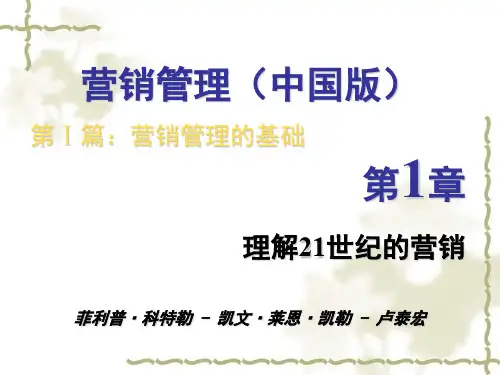
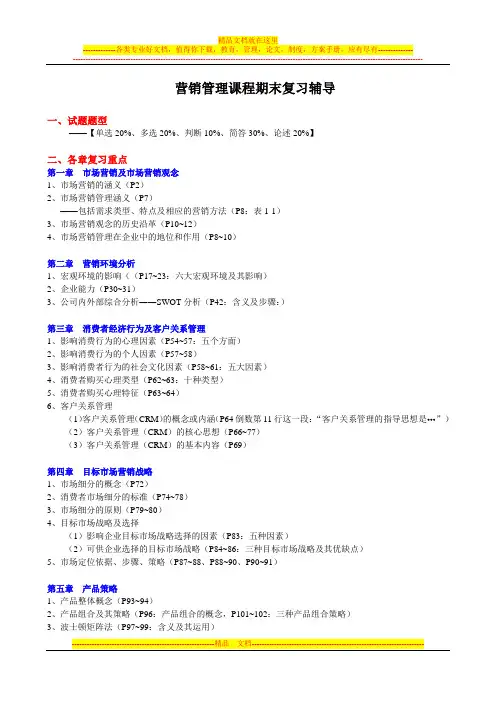
营销管理课程期末复习辅导一、试题题型——【单选20%、多选20%、判断10%、简答30%、论述20%】二、各章复习重点第一章市场营销及市场营销观念1、市场营销的涵义(P2)2、市场营销管理涵义(P7)——包括需求类型、特点及相应的营销方法(P8:表1-1)3、市场营销观念的历史沿革(P10~12)4、市场营销管理在企业中的地位和作用(P8~10)第二章营销环境分析1、宏观环境的影响((P17~23:六大宏观环境及其影响)2、企业能力(P30~31)3、公司内外部综合分析――SWOT分析(P42:含义及步骤:)第三章消费者经济行为及客户关系管理1、影响消费行为的心理因素(P54~57:五个方面)2、影响消费行为的个人因素(P57~58)3、影响消费者行为的社会文化因素(P58~61:五大因素)4、消费者购买心理类型(P62~63:十种类型)5、消费者购买心理特征(P63~64)6、客户关系管理(1)客户关系管理(CRM)的概念或内涵(P64倒数第11行这一段:“客户关系管理的指导思想是…”)(2)客户关系管理(CRM)的核心思想(P66~77)(3)客户关系管理(CRM)的基本内容(P69)第四章目标市场营销战略1、市场细分的概念(P72)2、消费者市场细分的标准(P74~78)3、市场细分的原则(P79~80)4、目标市场战略及选择(1)影响企业目标市场战略选择的因素(P83:五种因素)(2)可供企业选择的目标市场战略(P84~86:三种目标市场战略及其优缺点)5、市场定位依据、步骤、策略(P87~88、P88~90、P90~91)第五章产品策略1、产品整体概念(P93~94)2、产品组合及其策略(P96:产品组合的概念,P101~102:三种产品组合策略)3、波士顿矩阵法(P97~99:含义及其运用)4、产品生命周期各阶段的营销策略(P106~109)5、新产品开发风险(P114~115)6、品牌策略(P116~119:五种策略或决策)第六章价格策略1、企业定价目标(P130~131:五种定价目标)2、企业定价方法(P132~135:三种导向定价法,各有几种具体的定价法)3、企业定价策略(1)新产品定价策略(P135~137)(2)产品组合定价策略(P137~138)(3)地区定价策略(P138~139)(4)心理定价策略(P139~140)(5)折扣与让利定价策略(P140~141)(6)价格调整策略(P141~142)第七章促销策略1、影响促销组合决策的因素(P144~146:七个因素)2、广告策略(P152~153)3、人员推销的特点、技巧(P155~156、P156~159)4、营业推广的概念、方式、实施(P161、P161~163、P163~164)第八章分销渠道策略1、分销渠道的基本类型(P174~176)2、中间商的基本类型(P177~179)3、影响销售渠道选择的因素(P180~182)4、零售商营销决策(P187~188)5、中间商策略的选择(P189)6、分销渠道的策略的选择(P190~191)7、渠道调整策略(P191~192)第九章营销人员1、营销人员的基本能力(P205~209:十种能力)2、培养实践能力的方法和途径(P210~211)第十章国际市场营销战略1、国际市场营销战略的演进历程(P228:倒数第三段“其一;其二;其三;其四”)2、国际市场进入战略(P232:第二节)3、国际市场营销战略组合(第三节~第六节,即国际市场的4P营销组合战略:国际市场产品战略、国际市场定价战略、国际市场促销战略、国际市场分销渠道战略)第十一章市场营销组织与管理1、市场营销组织的概念、特征和原则(P259、P260 、P260~261)2、企业的整体营销(P265~266)3、市场营销控制的三种类型(P267~270)第十二章市场营销发展的新趋势1、整合营销(概念:P278顺数第三段,内涵:P278~282一、二、三标题)三、综合练习题(以“营销管理往届试题”作为练习题)【另附】。

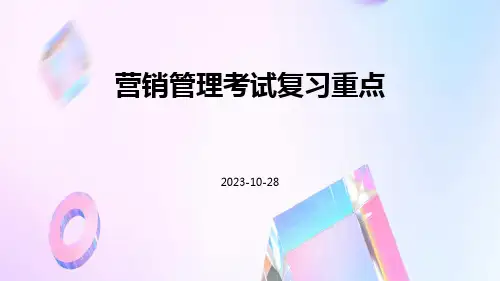

营销复习重点集团文件发布号:(9816-UATWW-MWUB-WUNN-INNUL-DQQTY-市场营销学复习重点一、简答题(每小题3分,共12分)(答出基本要点)1.市场挑战者的进攻策略 330正面攻击,侧翼攻击,围堵攻击,迂回攻击,游击战2.市场防守者的防守策略 327阵地防御,侧翼防御,先发防御,反攻防御,运动防御,收缩防御3.集中战略 254-255+上课补充把经营战略的重点放在一个特定目标市场上,为特定的地区或特定的购买者集团提供特殊的产品和服务。
4.竞争对手的优劣势分析 303+上课补充1.竞争对手是谁?2.竞争对手的优势在哪里,劣势在哪里?3.在他的劣势里我们能孕育出战胜它的力量吗?4.在他的优势里我们有超过他的可能吗?5.我们的核心竞争力是什么?5.渠道设计的主要步骤 459分析顾客需求,建立渠道目标和约束,识别主要渠道方案,评估主要渠道方案6.广告决策的程序544设定目标决定广告预算开发广告活动信息决策媒体决策效果测量7.整合营销和整合营销传播24 518营销策略、活动的协调一致。
整合营销传播主要有广告、销售促进、事件和体验、公共关系和宣传、直销、互动营销、口碑营销、人员销售八种方式。
二、简述题(每题9分,共18分)1.营销基本概念:(1)需要、需求、欲望;10需要(needs)描述的是人类固有的基本要求,比如衣、食、住、行等,也指某种基本要求还没有得到满足时的一种心理状态。
欲望(wants)是想得到某种具体的东西以满足某种需要的愿望。
需求(demands)是指有购买力支撑的欲望。
(2)产品、服务;7; 385产品(或市场供应物)是提供给市场的、供顾客购买、使用、消费的、能满足顾客某种需要或者欲望的任何东西。
(3)顾客价值、顾客满意;143;147顾客价值是顾客消费特定产品所获得的纯利益;顾客满意是指顾客在比较价值和期望值之后所产生的感觉状态。
顾客满意(4)交易(指双方以货币为媒介的价值交换。
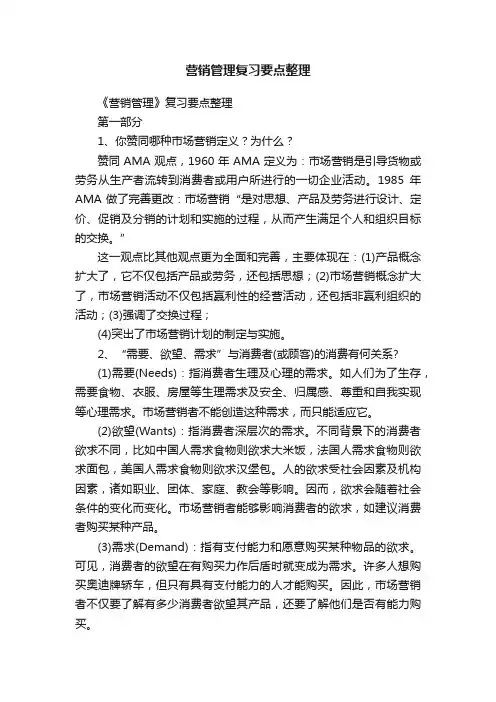
营销管理复习要点整理《营销管理》复习要点整理第一部分1、你赞同哪种市场营销定义?为什么?赞同AMA观点,1960年AMA定义为:市场营销是引导货物或劳务从生产者流转到消费者或用户所进行的一切企业活动。
1985年AMA做了完善更改:市场营销“是对思想、产品及劳务进行设计、定价、促销及分销的计划和实施的过程,从而产生满足个人和组织目标的交换。
”这一观点比其他观点更为全面和完善,主要体现在:(1)产品概念扩大了,它不仅包括产品或劳务,还包括思想;(2)市场营销概念扩大了,市场营销活动不仅包括赢利性的经营活动,还包括非赢利组织的活动;(3)强调了交换过程;(4)突出了市场营销计划的制定与实施。
2、“需要、欲望、需求”与消费者(或顾客)的消费有何关系?(1)需要(Needs):指消费者生理及心理的需求。
如人们为了生存,需要食物、衣服、房屋等生理需求及安全、归属感、尊重和自我实现等心理需求。
市场营销者不能创造这种需求,而只能适应它。
(2)欲望(Wants):指消费者深层次的需求。
不同背景下的消费者欲求不同,比如中国人需求食物则欲求大米饭,法国人需求食物则欲求面包,美国人需求食物则欲求汉堡包。
人的欲求受社会因素及机构因素,诸如职业、团体、家庭、教会等影响。
因而,欲求会随着社会条件的变化而变化。
市场营销者能够影响消费者的欲求,如建议消费者购买某种产品。
(3)需求(Demand):指有支付能力和愿意购买某种物品的欲求。
可见,消费者的欲望在有购买力作后盾时就变成为需求。
许多人想购买奥迪牌轿车,但只有具有支付能力的人才能购买。
因此,市场营销者不仅要了解有多少消费者欲望其产品,还要了解他们是否有能力购买。
3、从现代营销观角度看“效用”与营销的关系及其意义。
消费者如何选择所需的产品,主要是根据对满足其需要的每种产品的效用进行估价而决定的。
效用是消费者对满足其需要的产品的全部效能的估价。
4、如何理解现代营销不是“交易营销”?交易营销是指厂商着眼于一次的交换或交易,分析的单位是一次的市场交易,厂商的利润来源就是该次的交易,是一种相当短期的市场行为。
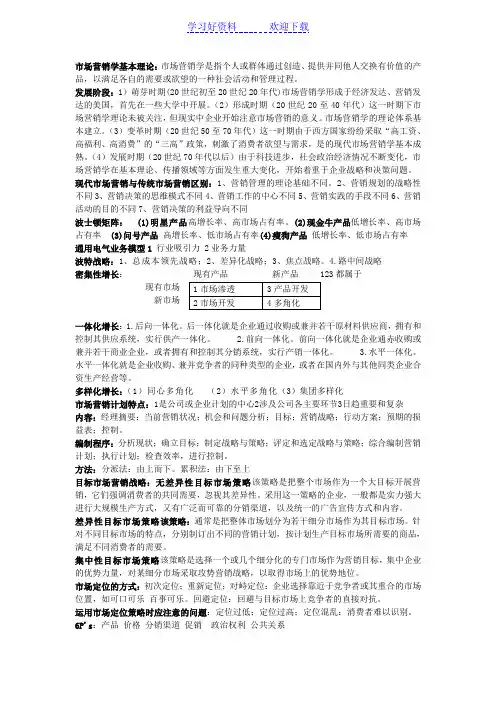
市场营销学基本理论:市场营销学是指个人或群体通过创造、提供并同他人交换有价值的产品,以满足各自的需要或欲望的一种社会活动和管理过程。
发展阶段:1)萌芽时期(20世纪初至20世纪20年代)市场营销学形成于经济发达、营销发达的美国,首先在一些大学中开展。
(2)形成时期(20世纪20至40年代)这一时期下市场营销学理论未被关注,但现实中企业开始注意市场营销的意义。
市场营销学的理论体系基本建立。
(3)变革时期(20世纪50至70年代)这一时期由于西方国家纷纷采取“高工资、高福利、高消费”的“三高”政策,刺激了消费者欲望与需求,是的现代市场营销学基本成熟。
(4)发展时期(20世纪70年代以后)由于科技进步,社会政治经济情况不断变化,市场营销学在基本理论、传播领域等方面发生重大变化,开始着重于企业战略和决策问题。
现代市场营销与传统市场营销区别:1、营销管理的理论基础不同。
2、营销规划的战略性不同3、营销决策的思维模式不同4、营销工作的中心不同5、营销实践的手段不同6、营销活动的目的不同7、营销决策的利益导向不同波士顿矩阵: (1)明星产品高增长率、高市场占有率。
(2)现金牛产品低增长率、高市场占有率 (3)问号产品 高增长率、低市场占有率(4)瘦狗产品 低增长率、低市场占有率通用电气业务模型1 行业吸引力 2业务力量波特战略:1、总成本领先战略;2、差异化战略;3、焦点战略。
4.路中间战略密集性增长: 现有产品 新产品 123都属于现有市场 新市场一体化增长:1.后向一体化。
后一体化就是企业通过收购或兼并若干原材料供应商,拥有和控制其供应系统,实行供产一体化。
2.前向一体化。
前向一体化就是企业通赤收购或兼并若干商业企业,或者拥有和控制其分销系统,实行产销一体化。
3.水平一体化。
水平一体化就是企业收购、兼并竞争者的同种类型的企业,或者在国内外与其他同类企业合资生产经营等。
多样化增长:(1)同心多角化 (2)水平多角化(3)集团多样化市场营销计划特点:1是公司或企业计划的中心2涉及公司各主要环节3日趋重要和复杂内容:经理摘要;当前营销状况;机会和问题分析;目标;营销战略;行动方案;预期的损益表;控制。
